A Holy Challenge
After eight days had passed, it was time to circumcise the child; and he was called Jesus, the name given by the angel before he was conceived in the womb.We remember on this day that Mary and Joseph were faithful Jews who did all for Jesus that was required by Moses' Law. Jesus would redeem humankind from within and through the covenant of God made with Moses.
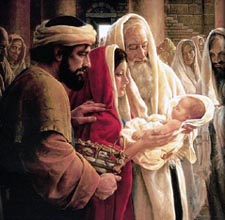 This passage and a few others give us a glimpse into those shadowy years of Jesus’ youth. We know that Jesus grew up in life of Jeiwsh ritual observance, which found its pattern in the Law of Moses and its purpose in drawing closer to God. Jesus’ parents were both careful in following the letter of the law and thoughtful in understanding with their hearts what their actions signified. We know that Jesus did not suddenly become obedient to God as an adult, but was actually raised by parents who both taught and practiced obedience to God in their home. This makes The Holy Family a model for our own families, by challenging us to raise our own children to be obedient to God as well as following God's commandments ourselves.
This passage and a few others give us a glimpse into those shadowy years of Jesus’ youth. We know that Jesus grew up in life of Jeiwsh ritual observance, which found its pattern in the Law of Moses and its purpose in drawing closer to God. Jesus’ parents were both careful in following the letter of the law and thoughtful in understanding with their hearts what their actions signified. We know that Jesus did not suddenly become obedient to God as an adult, but was actually raised by parents who both taught and practiced obedience to God in their home. This makes The Holy Family a model for our own families, by challenging us to raise our own children to be obedient to God as well as following God's commandments ourselves.peace,
Frank+
The Rev. Frank Logue, Pastor + King of Peace Episcopal Church
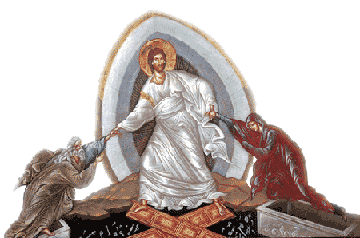
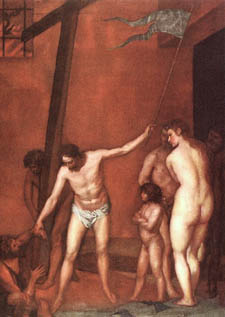 has some real-life consequences. The church is growing most in poor places like Africa and Asia where infant mortality remains high. While the concerns of the experts reconsidering limbo are more theological, it does not hurt the church's future if an African mother who has lost a baby can receive more hopeful news from her priest in 2005 than, say, an Italian mother did 100 years ago.
has some real-life consequences. The church is growing most in poor places like Africa and Asia where infant mortality remains high. While the concerns of the experts reconsidering limbo are more theological, it does not hurt the church's future if an African mother who has lost a baby can receive more hopeful news from her priest in 2005 than, say, an Italian mother did 100 years ago.

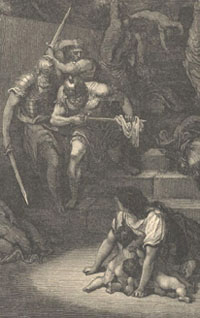 Herod represents the dark side of the gospel. He reminds us that Jesus didn't enter a world of sparkly Christmas cards or a world of warm spiritual sentiment. Jesus enters a world of real pain, of serious dysfunction, a world of brokenness and political oppression. Jesus was born an outcast, a homeless person, a refugee, and finally he becomes a victim to the powers that be. Jesus is the perfect savior for outcasts, refugees, and nobodies. That's how the church is described in scripture time and time again—not as the best and the brightest—but those who in their weakness become a sign for the world of the wisdom and power of God.
Herod represents the dark side of the gospel. He reminds us that Jesus didn't enter a world of sparkly Christmas cards or a world of warm spiritual sentiment. Jesus enters a world of real pain, of serious dysfunction, a world of brokenness and political oppression. Jesus was born an outcast, a homeless person, a refugee, and finally he becomes a victim to the powers that be. Jesus is the perfect savior for outcasts, refugees, and nobodies. That's how the church is described in scripture time and time again—not as the best and the brightest—but those who in their weakness become a sign for the world of the wisdom and power of God.

 Leigh holds a MS degree in biology and began her art career 14 years ago in biological illustration. She has studied painting and design at the University of Hawaii, Montana State University and participated in Smithsonian Institute workshops. Leigh has had the opportunity to teach watercolor and botanical illustration classes at local art centers in Montana, Oregon and Winder, GA. Her works, although diverse in subject and focus, share a commonality in a strong use of color and design. Her paintings have been exhibited in juried and private shows from Hawaii to Georgia. Leigh has illustrated 5 books for Menasha Ridge Press and is an active member of the Oconee Cultural Arts Foundation and the Georgia Watercolor Society.
Leigh holds a MS degree in biology and began her art career 14 years ago in biological illustration. She has studied painting and design at the University of Hawaii, Montana State University and participated in Smithsonian Institute workshops. Leigh has had the opportunity to teach watercolor and botanical illustration classes at local art centers in Montana, Oregon and Winder, GA. Her works, although diverse in subject and focus, share a commonality in a strong use of color and design. Her paintings have been exhibited in juried and private shows from Hawaii to Georgia. Leigh has illustrated 5 books for Menasha Ridge Press and is an active member of the Oconee Cultural Arts Foundation and the Georgia Watercolor Society. The odd part is that I took my sister's beautiful watercolor, which is well framed and matted and hung it over the water fountain in the entry hall (Mom helped). It would seem to be a humble setting for such a moving work of art. But why shouldn't God's house be adorned with fine art, even or even especially over the water fountain. How—dare I say it—refreshing.
The odd part is that I took my sister's beautiful watercolor, which is well framed and matted and hung it over the water fountain in the entry hall (Mom helped). It would seem to be a humble setting for such a moving work of art. But why shouldn't God's house be adorned with fine art, even or even especially over the water fountain. How—dare I say it—refreshing. 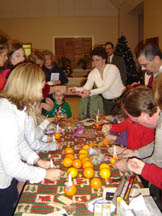
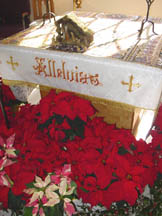 Photos of Christmas Eve and Christmas Day are now online.
Photos of Christmas Eve and Christmas Day are now online.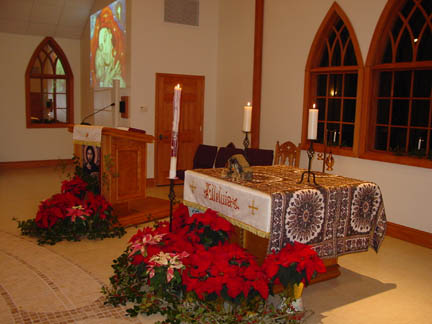
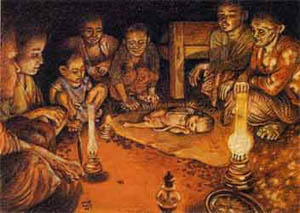



 Tonight's candlelight communion service will be at 6 p.m., though kids will want to be there by 5:40 p.m. in order to have time to make their own Christ Light (see photo at right).
Tonight's candlelight communion service will be at 6 p.m., though kids will want to be there by 5:40 p.m. in order to have time to make their own Christ Light (see photo at right). 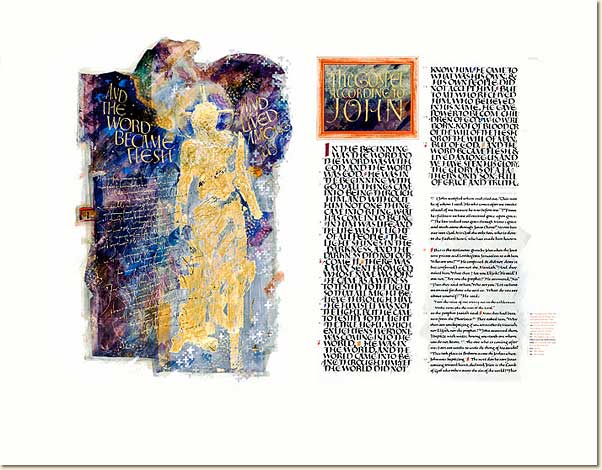
 He was in the beginning with God. All things came into being through Him, and apart from Him nothing came into being that has come into being. In Him was life, and the life was the Light of men. The Light shines in the darkness, and the darkness did not comprehend it. There came a man sent from God, whose name was John. He came as a witness, to testify about the Light, so that all might believe through him. He was not the Light, but he came to testify about the Light. There was the true Light which, coming into the world, enlightens every man. He was in the world, and the world was made through Him, and the world did not know Him. He came to His own, and those who were His own did not receive Him. But as many as received Him, to them He gave the right to become children of God, even to those who believe in His name, who were born, not of blood nor of the will of the flesh nor of the will of man, but of God. And the Word became flesh, and dwelt among us, and we saw His glory, glory as of the only begotten from the Father, full of grace and truth.
He was in the beginning with God. All things came into being through Him, and apart from Him nothing came into being that has come into being. In Him was life, and the life was the Light of men. The Light shines in the darkness, and the darkness did not comprehend it. There came a man sent from God, whose name was John. He came as a witness, to testify about the Light, so that all might believe through him. He was not the Light, but he came to testify about the Light. There was the true Light which, coming into the world, enlightens every man. He was in the world, and the world was made through Him, and the world did not know Him. He came to His own, and those who were His own did not receive Him. But as many as received Him, to them He gave the right to become children of God, even to those who believe in His name, who were born, not of blood nor of the will of the flesh nor of the will of man, but of God. And the Word became flesh, and dwelt among us, and we saw His glory, glory as of the only begotten from the Father, full of grace and truth.  Two of these are gifts of Mary Root—given to the Glory of God and in memory of her parents, Florence and Joe Terrando. The first painting is "Peace Be Still" a 30"x30" print by He Qi (pronounced "Huh Chee"). Shown here at right, this is his interpretation of Jesus calming the waters. Known for his brilliant use of color in designs which grow out of his own Chinese culture, He Qi (pictured below) has a growing artistic following. Christian Times noted in an article,
Two of these are gifts of Mary Root—given to the Glory of God and in memory of her parents, Florence and Joe Terrando. The first painting is "Peace Be Still" a 30"x30" print by He Qi (pronounced "Huh Chee"). Shown here at right, this is his interpretation of Jesus calming the waters. Known for his brilliant use of color in designs which grow out of his own Chinese culture, He Qi (pictured below) has a growing artistic following. Christian Times noted in an article,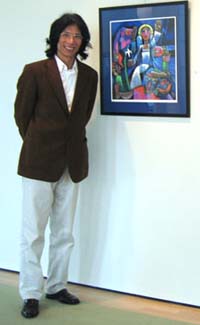 He hopes to help change the "foreign image" of Christianity in China by using artistic language, and at the same time, to supplement Chinese Art the way Buddhist art did in ancient times. In his works, He Qi has blended together Chinese folk customs and traditional Chinese painting techniques with the western art of the Middle and Modern Ages, and has created an artistic style of color-on-paper painting.
He hopes to help change the "foreign image" of Christianity in China by using artistic language, and at the same time, to supplement Chinese Art the way Buddhist art did in ancient times. In his works, He Qi has blended together Chinese folk customs and traditional Chinese painting techniques with the western art of the Middle and Modern Ages, and has created an artistic style of color-on-paper painting. 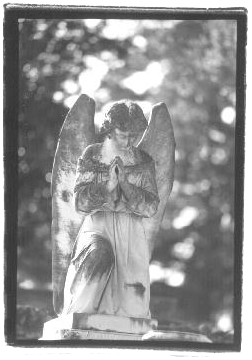 If on the other hand, the activity of God is precarious creativity, ever poised between tragedy and triumph, ever redeeming tragedy into triumph; and if the Church is responsive offering to God; then the intercession of the Church is the offering of its own will to participate, to uphold, to support.
If on the other hand, the activity of God is precarious creativity, ever poised between tragedy and triumph, ever redeeming tragedy into triumph; and if the Church is responsive offering to God; then the intercession of the Church is the offering of its own will to participate, to uphold, to support.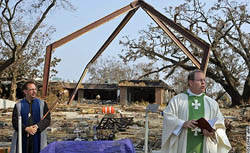 I want to thank you for your patience and wonderful support. Although Christmas on the Coast will be very different for most of us, we have been incredibly blessed by the generosity of so many of you. I am behind in my Thank You notes, but I do want to assure you that your support has been wonderful. One of the real joys that I have been experiencing this past week has been to be Santa Claus with somebody else’s money. These monetary gifts have done amazing things to lift the spirits of struggling families.
I want to thank you for your patience and wonderful support. Although Christmas on the Coast will be very different for most of us, we have been incredibly blessed by the generosity of so many of you. I am behind in my Thank You notes, but I do want to assure you that your support has been wonderful. One of the real joys that I have been experiencing this past week has been to be Santa Claus with somebody else’s money. These monetary gifts have done amazing things to lift the spirits of struggling families. The stereotype of an Anglican priest is someone who visits parishioners in the morning and spends the afternoon writing metaphysical poetry. Probably only true historically of George Herbert and to a lesser degree (as he didn't visit parishioners so much) John Donne, it is also true of the present Archbishop of Canterbury, Rowan Williams. The following poem, titled Advent Calendar is from
The stereotype of an Anglican priest is someone who visits parishioners in the morning and spends the afternoon writing metaphysical poetry. Probably only true historically of George Herbert and to a lesser degree (as he didn't visit parishioners so much) John Donne, it is also true of the present Archbishop of Canterbury, Rowan Williams. The following poem, titled Advent Calendar is from  But, on the other hand, many people seem to believe that if immediate improvement is not experienced after one prayer, then healing prayer is a waste of time, and they give up. I'm not saying that dramatic healings don't happen—they do with medecine and healing prayer, but most often healing is gradual. The body, when wounded, undergoes a sequence of physiological events known as the healing process. That process takes time even when enhanced by modern medecines, advanced by surgical techniques, and healing prayer. The point here is that in medecine we keep on treating as long as there is hope for recovery. Bottom line—we don't give up—persistence is our battle cry.
But, on the other hand, many people seem to believe that if immediate improvement is not experienced after one prayer, then healing prayer is a waste of time, and they give up. I'm not saying that dramatic healings don't happen—they do with medecine and healing prayer, but most often healing is gradual. The body, when wounded, undergoes a sequence of physiological events known as the healing process. That process takes time even when enhanced by modern medecines, advanced by surgical techniques, and healing prayer. The point here is that in medecine we keep on treating as long as there is hope for recovery. Bottom line—we don't give up—persistence is our battle cry.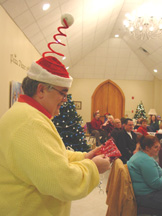





 Note: Today's religion column in the Tribune & Georgian is the first of two parts. It was originally written as my Christmas Eve sermon for 2003. If you want to look ahead, an illustrated version of the full story is here:
Note: Today's religion column in the Tribune & Georgian is the first of two parts. It was originally written as my Christmas Eve sermon for 2003. If you want to look ahead, an illustrated version of the full story is here:  Lack of interior peace threatens the whole frabric of the community and that is why St. Benedict starts here, where that lack of peace begins, inside ourselves, with the murmuring which fragments and destroys us. When there is so much concern today with the peace of the world, when peace movements multiply and peace groups proliferate, and the discussion of peace-making becomes more and more urgent and insistent, St. Benedict brings us back to this very simple and basic root: peace must start within myself. How can I hope to contribute to the peace of the world when I cannot resolve my own inner conflicts?
Lack of interior peace threatens the whole frabric of the community and that is why St. Benedict starts here, where that lack of peace begins, inside ourselves, with the murmuring which fragments and destroys us. When there is so much concern today with the peace of the world, when peace movements multiply and peace groups proliferate, and the discussion of peace-making becomes more and more urgent and insistent, St. Benedict brings us back to this very simple and basic root: peace must start within myself. How can I hope to contribute to the peace of the world when I cannot resolve my own inner conflicts?







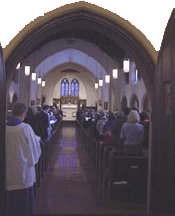
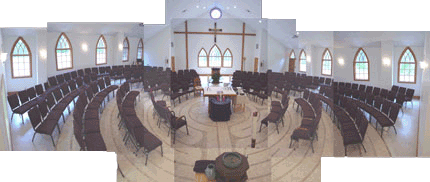
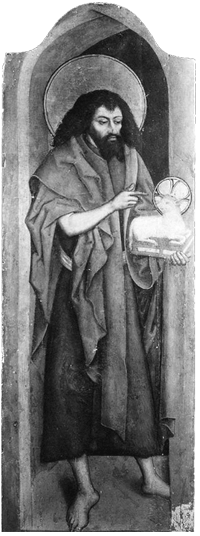 In
In 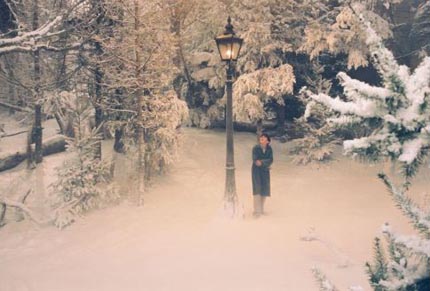
 Perhaps it has sometimes happened to you in a dream that someone says something which you don't understand but in the dream it feels as if it had some enormous meaning—either a terrifying one which turns the whole dream into a nightmare or else a lovely meaning too lovely to put into words, which makes the dream so beautiful that you remember it all your life and are always wishing you could get into that dream again. It was like that now. At the name Aslan each one of the children felt something jump in its inside. Edmund felt a sensation of mysterious horror. Peter felt suddenly brave and adventerous. Susan felt as if some delicious smell or some delighful strain of music had just floated by her. And Lucy got the feeling you have when you wake up in the morning and realize that it is the beginning of the holidays or the beginning of summer.
Perhaps it has sometimes happened to you in a dream that someone says something which you don't understand but in the dream it feels as if it had some enormous meaning—either a terrifying one which turns the whole dream into a nightmare or else a lovely meaning too lovely to put into words, which makes the dream so beautiful that you remember it all your life and are always wishing you could get into that dream again. It was like that now. At the name Aslan each one of the children felt something jump in its inside. Edmund felt a sensation of mysterious horror. Peter felt suddenly brave and adventerous. Susan felt as if some delicious smell or some delighful strain of music had just floated by her. And Lucy got the feeling you have when you wake up in the morning and realize that it is the beginning of the holidays or the beginning of summer. The difficulty is that most of the time I am so busy and so involved that I simply have not the time (nor the incentive) to see my daily life and work in this sort of way at all. Yet that deeply sacramental understanding which emphasizes common creation, which plays down the division between the sacred and the secular, which brings awareness that all comes from God, is something which speaks most immediately to my condition and I am a fool if I do not hear it. For it enables me to seek God here and now, just as I am, caught up in all the absurdly down-to-earth chores and demands which I feel trap me day by day....
The difficulty is that most of the time I am so busy and so involved that I simply have not the time (nor the incentive) to see my daily life and work in this sort of way at all. Yet that deeply sacramental understanding which emphasizes common creation, which plays down the division between the sacred and the secular, which brings awareness that all comes from God, is something which speaks most immediately to my condition and I am a fool if I do not hear it. For it enables me to seek God here and now, just as I am, caught up in all the absurdly down-to-earth chores and demands which I feel trap me day by day....








0 Comments:
Post a Comment
<< Home